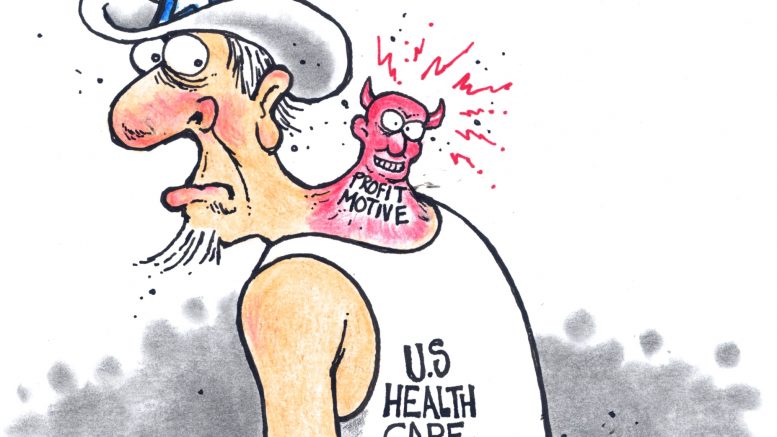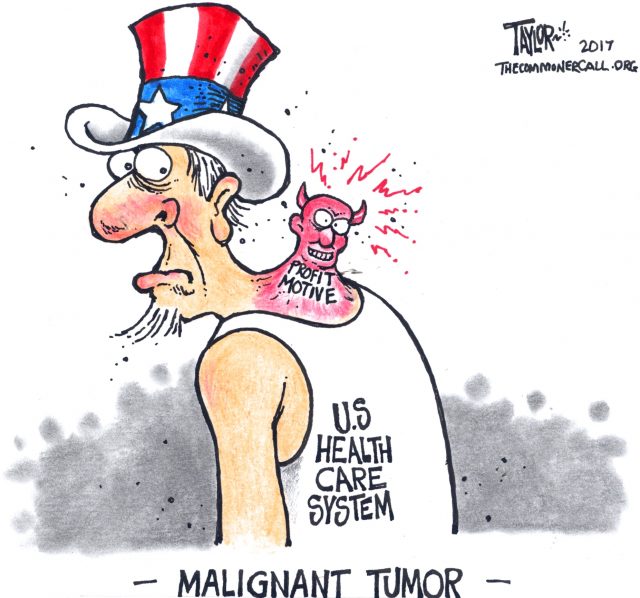A system designed to fail.
By Dr. Carol Paris
Common Dreams (7/28/17)
Hundreds of people slept overnight in cars, or camped for days in a field. They told storiesof yanking out their own teeth with pliers, of reusing insulin syringes until they broke in their arm, of chronic pain so debilitating they could hardly care for their own children. At daybreak, they lined up for several more hours outside a white tent, waiting for their chance to visit a doctor. For many, this was the first health care provider they’ve seen in years.
Is this a place torn by war, famine or natural disaster? No, this charity medical clinic was last weekend in southwest Virginia, in the wealthiest country in the world, where we spend nearly three times as much money on health care as other similar countries.
And what do we get for our money? The very definition of health care rationing: 28 million Americans without insurance, and millions more insured, but avoiding treatment because of sky-high deductibles and co-pays. Compared to ten other wealthy countries, the U.S. ranks dead last for life expectancy, and access to care. We even have the lowest number of hospital beds per capita, a way that health experts measure the capacity of a nation’s health system. It’s as if our system was designed to deny care.
“The good news is that we already have a proven model for health financing that is popular among both patients and physicians.”
America does hit the top of the list in some areas. Compared to other nations, American doctors and patients waste the most hours on billing and insurance claims. We have the highest rate of infant mortality, and the highest percentage of avoidable deaths—patients who die from complications or conditions that could have been avoided with timely care.
Clearly, this system is broken. Like a cracked pipe, money gushes into our health care system but steadily leaks out. Money is siphoned into the advertising budgets of insurance companies and the army of corporate bureaucrats working to deny claims. Even more dollars are soaked up by the pockets of insurance CEOs who have collectively earned $9.8 billion since the Affordable Care Act was passed in 2010. Nearly a third of our health care dollars go to something other than health care.
President Trump recognized voters’ frustration and campaigned on a promise of more coverage, better benefits, and lower costs. We couldn’t agree more with these goals. However, instead of trying to fix our broken system, GOP leaders are acting more like toddlers, mid-tantrum, smashing our health system into smaller and smaller pieces, threatening to push even more Americans—the most vulnerable among us—through the cracks. Last night, a few Senate Republicans stood up and acted like adults, putting an end to this dangerous game.
Today, we breathe a quick sigh of relief. But we cannot celebrate a return to the status quo, a system that rations health care based on income and allows 18,000 Americans to die each year unnecessarily.
Where do we go from here?
Republicans had eight years to come up with a plan that achieves more coverage, better benefits and lower costs. Have our elected leaders simply run out of ideas?
The good news is that we already have a proven model for health financing that is popular among both patients and physicians. It provides medically-necessary care to the oldest and sickest Americans with a fraction of the overhead of private insurance. It’s called Medicare, and I can tell you as a physician that it has worked pretty darn well for more than 50 years.
Not only do we have a model, we have a bill that would expand Medicare to cover everyone and improve it to include prescriptions, dental, vision, and long-term care. It’s called H.R. 676, the Expanded and Improved Medicare for All Act, a single-payer plan that would provide comprehensive care to everyone living in the U.S. The bill would yield about $500 billion annually in administrative savings while covering the 28 million currently uninsured. Medicare for all is gaining steam with a record 115 co-sponsors, a majority of House Democrats.
Now that Republican senators have finally worn themselves out, Sen. Bernie Sanders plans to file his own single-payer Medicare for all bill. Senators from both parties will be asked to choose a side: Do you support the current system of health care rationing, medical bankruptcies and unnecessary deaths; or a program proven to work both here and in every other developed country?
A majority of Americans now believe that health care is a human right, and that it is our government’s responsibility to achieve universal coverage. We’ve tried everything else except Medicare for all. What are we waiting for?
(Dr. Carol Paris is a psychiatrist and president of Physicians for a National Health Program (PNHP).
(This work is licensed under a Creative Commons Attribution-Share Alike 3.0 License.)
(Commoner Call cartoon by Mark L. Taylor, 2017. Open source and free to use with link to www.thecommonercall.org )
*****
Medicare For All vs. All The Healthcare That Each Can Afford
By Jane Sanders
The Sanders Institute / July 2017
We stand at the crossroads between guaranteeing healthcare to everyone through an improved and expanded Medicare program and leaving increasingly more people at the mercy of the market with legislation such as the American Health Care Act. Now is the time to take on our market-driven system and fight for an improved and expanded Medicare for all.1
In contrast to our current system, a Medicare-for-all health plan would provide comprehensive healthcare benefits for all medically appropriate care without regard to income, employment, or health status. Instead of many insurers, each with a variety of health plans and cost-sharing schemes, funding for healthcare would be administered from a single government fund based on a uniform set of benefits.2 Payments would be negotiated by representatives of the Medicare-for-all plan and representatives of hospitals, physicians, and other providers. Finally, prescription drugs, medical devices, and other related supplies would be negotiated in bulk for the entire U.S. population at reduced prices. There would be a single standard of excellence in care for all – not bronze for some and platinum for others. People would be free to seek care from any participating healthcare provider. We would receive the care our doctors and nurses determine we need – not what a profit-seeking insurer deems it will cover or deny. Finally, care would be provided without deductibles or copayments thereby easing economic inequality and health disparities.
Although the United States consistently spends more on healthcare than any other country, it typically has poorer results.
This paper begins by examining our market-driven healthcare system and the failings of our private insurance system. It includes discussions on why adding a government-run public insurance option to the ACA private insurance marketplaces could not remedy the problems the marketplaces face and on the limitations in care under a market-driven system. Finally, it will examine the major features of a Medicare-for-all system and how our country could provide healthcare as a right, not a privilege.
Corporate Healthcare and the Games Insurers Play
For decades, corporate healthcare has played a major role in defeating attempts to guarantee healthcare for all. The influence of this sector decisively shaped the Affordable Care Act (ACA). In the years leading up to and following the passage of the ACA, 2006 through 2012, the health sector spent $3.4 billion on lobbying – more than any other sector for four out of seven years and second for the other three.3 It also contributed a whopping $709 million in campaign contributions over that same time period. 4 Of this $709 million, $332 million went to Republicans, $304 million went to Democrats ($23 million to candidate Obama in 2008), and the balance went to outside spending groups. The “investment” in lobbying and campaign contributions paid off. By spending these vast sums, corporate healthcare was able to block measures that would have improved our healthcare system, but interfered with the health industry’s ability to reap enormous profits, and win provisions that guaranteed increased healthcare industry profits.
Still, in many ways, the ACA was a step forward. Those with pre-existing conditions can no longer be denied coverage and insurers cannot base premiums on health status. The number of uninsured has dropped considerably, with 20.4 million gaining coverage from 2010 to 2016.5 Unfortunately, the ACA didn’t go far enough. With plans available in the ACA insurance marketplaces requiring cost sharing ranging from 10% to 40%, on top of premiums, cost continues to make it prohibitive for many to access healthcare. Catastrophic plans are even worse. Even though the federal government has been propping up the insurance marketplaces through premium support and cost-sharing subsidies, paid by taxpayers to private insurers, these insurance marketplaces have struggled from the beginning. These struggles have been exacerbated under the current administration. …
Read the Rest and 1+-Minute Video
*****
Why Single-Payer Health Care Saves Money
By Robert H. Frank
The New York Ties (7/7/17)
Lingering uncertainty about the fate of the Affordable Care Act has spurred the California legislature to consider adoption of a statewide single-payer health care system.
Sometimes described as Medicare for all, single-payer is a system in which a public agency handles health care financing while the delivery of care remains largely in private hands.
In short, the evidence is clear that single-payer delivers quality care at significantly lower cost than the current American hybrid system.
Discussions of the California measure have stalled, however, in the wake of preliminary estimates pegging the cost of the program as greater than the entire state government budget. Similar cost concerns derailed single-payer proposals in Colorado and Vermont.
Voters need to understand that this cost objection is specious. That’s because, as experience in many countries has demonstrated, the total cost of providing health coverage under the single-payer approach is actually substantially lower than under the current system in the United States. It is a bedrock economic principle that if we can find a way to do something more efficiently, it’s possible for everyone to come out ahead.
By analogy, suppose that your state’s government took over road maintenance from the county governments within it, in the process reducing total maintenance costs by 30 percent. Your state taxes would obviously have to go up under this arrangement. …
*****
Sanders: ‘We’re Figuring Out How We Can Mount A National Campaign’ For Single Payer
Common Dreams (7/30/17)
Sen. Bernie Sanders (I-Vt.) told Jake Tapper on CNN’s State of the Union Sunday that he will “absolutely” introduce legislation on single-payer healthcare now that the Senate GOP’s bill to repeal ObamaCare has failed.
“If people don’t like the private insurance that they’re getting, they should have a Medicare-type public option available in every state in this country,” Sanders said
Asked if he would follow through on his pledge to submit single-payer legislation, Sanders said, “Of course we are, we’re tweaking the final points of the bill and we’re figuring out how we can mount a national campaign to bring people together”
“We are the only major country on Earth not to guarantee health care to all people,” Sanders said, “We should … move in the direction of every other major country.”
“I believe at the end of the day, the American people will conclude that Medicare for all — Medicare is working now for people 65 or older — let’s expand it to everyone.”
(This work is licensed under a Creative Commons Attribution-Share Alike 3.0 License.)


